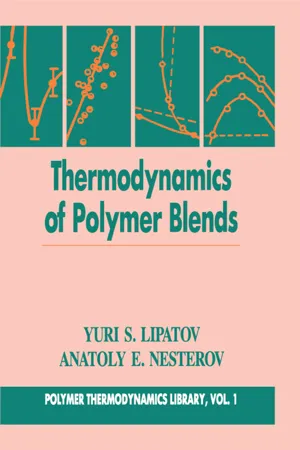
- 450 pages
- English
- ePUB (mobile friendly)
- Available on iOS & Android
Thermodynamics of Polymer Blends, Volume I
About This Book
Thermodynamics is an indispensable tool for developing a large and growing fraction of new polymers and polymer blends.
These two volumes show the researcher how thermodynamics can be used to rank polymer pairs in order of immiscibility, including the search for suitable chemical structure of compatibilizers.
Because of the great current commercial interest in this most dynamic sector of the polymer industry, there is high interest in studying their physical and mechanical properties, their structures, and the processes of their formation and manufacture.
These Books are dedicated to Analysis of the Thermodynamics of Polymer Blends. Thermodynamic behavior of blends determines the compatibility of the components, their morphological features, rheological behavior, and microphase structures. As a result, the most important physical and mechanical characteristics of blends can be identified.
The information in these two volumes will be useful to all those involved in polymer research, development, analysis and advanced process engineering.
Frequently asked questions
Chapter 1
BASIC PRINCIPLES OF THERMODYNAMICS OF POLYMER SOLUTIONS
1.1 THE MAIN THERMODYNAMIC CHARACTERISTICS OF SOLUTION
[1.1] |
[1.2] |
[1.3] |
[1.4] |
[1.5] |
[1.6] |
[1.7] |
[1.8] |
[1.9] |
Table of contents
- Cover
- Half Title
- Title Page
- Copyright Page
- Table of Contents
- Preface
- 1 Basic Principles of Thermodynamics of Polymer Solutions
- 2 Statistical Theories of Polymer Solutions
- 3 Thermodynamics of Polymer Mixing
- 4 Homopolymer-copolymer and Copolymer-copolymer Blends
- 5 Mechanism and Kinetics of Phase Separation in Polymer Solutions and Blends
- 6 Interface in Demixing Solutions and Polymer Mixtures
- Nomenclature
- Index